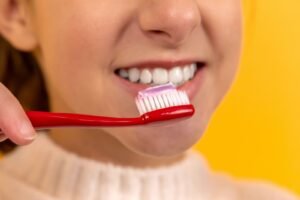Oral Health Tips For Adults
Tooth decay is the most common cause of pain of the mouth or face reported by adults, and most adults show signs of gum disease that results in a loss of teeth.
What You Can Do to Maintain Good Oral Health:
Avoid tobacco. In addition to heart disease, stroke, lung cancer and other diseases caused by tobacco, smokers have 7 times the risk of developing gum disease compared to non-smokers. Tobacco use in any form–cigarette, pipes, and smokeless (spit) tobacco–also increases the risk for cancers of the mouth and throat, and fungal infection of the mouth (Candidiasis). Advertising and movies often give teenagers the impression that smoking is “cool” or “sexy”. No one tells them about the stained teeth, stinky breath, gum disease and cavities. But by then it is often too late and they are addicted to the nicotine.
Limit alcohol. Heavy use of alcohol is also a risk factor for oral and throat cancers. When used alone, alcohol and tobacco are risk factors for oral cancers, but when used in combination the effects of alcohol and tobacco are even greater.
Eat wisely Avoiding sugars when snacking, this applies to adults as well as children. Limit the number of snacks eaten throughout the day. Increased amounts of fiber-rich fruits and vegetables are also very important. They stimulate salivary flow to aid remineralization of tooth surfaces with early stages of tooth decay.
Drink lots of safe water. If possible, drink fluoridated water and use a fluoride toothpaste. Fluoride’s protection against dental decay works at all ages. Thorough tooth brushing and flossing to reduce dental plaque can prevent tooth decay and gum disease. Brushing should be done at least twice a day (Usually after breakfast and always before bed) and flossing and using an interdental cleaner at least once (before bed).
How to Brush: Place your toothbrush at a 45-degree angle against the gums. Move the brush back and forth gently in short strokes. Brush the outer tooth surfaces, the inner tooth surfaces, and the chewing surfaces of the teeth. Brush your tongue to remove bacteria and freshen your breath.
How to Floss: Wind about 30 to 45 cm (12 to 18 inches) of floss around middle fingers of each hand. Pinch floss between thumbs and index fingers, leaving a 3 to 5 cm (1 to 2 inch) length in between. Keep this taut between your fingers. Use thumbs to direct floss between upper teeth. Use index fingers to guide floss between the lower teeth. Gently guide floss between the teeth by using a back and forth motion. Do not snap the floss into the gums. Curve it into a C shape against one tooth. Slide floss up and down against the tooth surface and under the gum line.
Always Rinse your mouth and “Swish” between the teeth with safe water after brushing or flossing, and also after eating snacks or whenever you are unable to brush and floss.


Comments